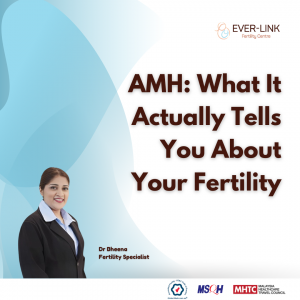
Anti Müllerian Hormone, or AMH, is one of the most common tests done when checking female fertility. It’s often marketed as your “fertility number,” and clinics may use it to guide treatment plans or suggest how many eggs you have left. But many women walk away from their AMH results either panicking because it’s low or feeling reassured because it’s high without fully understanding what it really means. Here’s the honest breakdown. AMH is a helpful test, but it’s also one of the most misunderstood. It doesn’t give you a yes-or-no answer about whether you can get pregnant. It simply offers a piece of the bigger puzzle.
What Is AMH and Why Is It Tested?
AMH is a hormone made by the small fluid filled sacs in your ovaries called follicles. These are the little structures that contain immature eggs. The more small follicles you have, the higher your AMH levels will be. That’s why AMH is used as a marker of ovarian reserve, or how many eggs are available at that point in time. It tends to be higher in younger women and declines with age, especially after 35. A review by Broer et al. (2014) in Human Reproduction Update confirmed that AMH is a reliable predictor of the number of antral follicles in the ovaries, and it’s commonly used in IVF clinics to estimate how many eggs can be retrieved during a cycle.
What AMH Can Tell You:
- Estimated Egg Quantity
AMH gives a rough idea of how many eggs are left in your ovaries. A high AMH means more follicles, while a low AMH means fewer. However, this number changes with age, lifestyle, and genetics.
- How You Might Respond to Fertility Treatment
During IVF, women with higher AMH levels often respond better to ovarian stimulation and produce more eggs. La Marca & Sunkara (2014) found that AMH is especially useful in predicting ovarian response and tailoring medication doses to avoid complications like ovarian hyperstimulation.
- Help in Diagnosing Conditions Like PCOS
Women with Polycystic Ovary Syndrome (PCOS) often have abnormally high AMH levels due to many small follicles in their ovaries.
What AMH Does NOT Tell You:
- Egg Quality
AMH says nothing about whether your eggs are healthy or chromosomally normal. Egg quality naturally declines with age, especially after 35, even if your AMH is high. Nelson et al. (2015) in Fertility and Sterility showed that AMH cannot reliably predict the chance of live birth in IVF cycles, highlighting the limitation of using AMH as a standalone fertility predictor.
- Your Ability to Get Pregnant Naturally
Many women with low AMH conceive naturally and many with high AMH still struggle. AMH does not reflect ovulation, fallopian tube health, uterine condition, or sperm factors. In fact, a well known study by Steiner et al. (2017) in JAMA concluded that AMH is not associated with natural conception rates in women aged 30 to 44.
- Your Menstrual Cycle or Hormonal Balance
AMH is steady throughout the month, but it doesn’t reflect how regularly you ovulate or whether your other hormones are balanced.
Conclusion:
AMH is a helpful tool especially when planning for fertility treatment but it’s not the ultimate fertility score. Think of it like checking your car’s fuel gauge before a trip. It tells you something important, but not everything. Low AMH doesn’t mean you’re infertile. High AMH doesn’t guarantee a baby. Fertility is complex, and AMH is just one piece of the story. If you’ve had an AMH test, talk to a fertility specialist who can look at your whole picture, age, hormone levels, ovulation, ultrasound scans, and your partner’s sperm health too.

